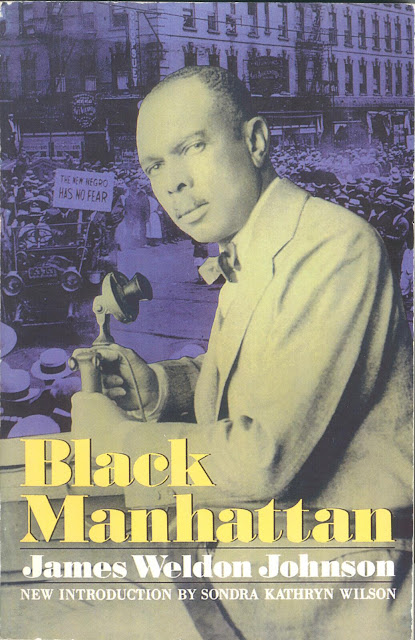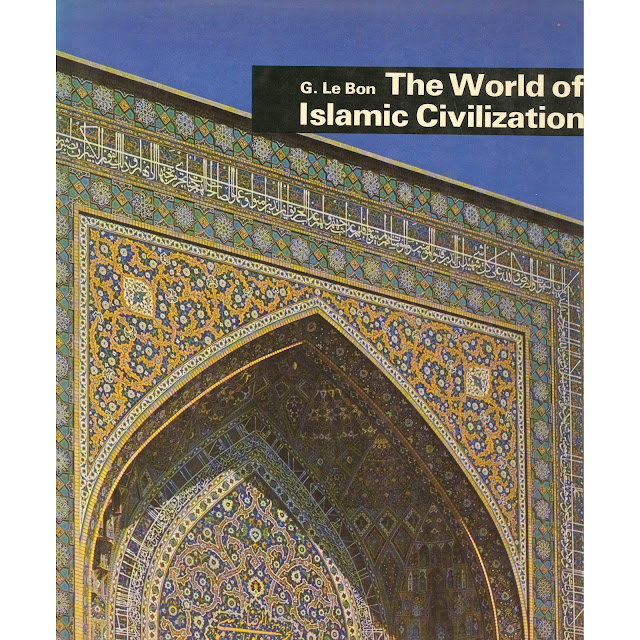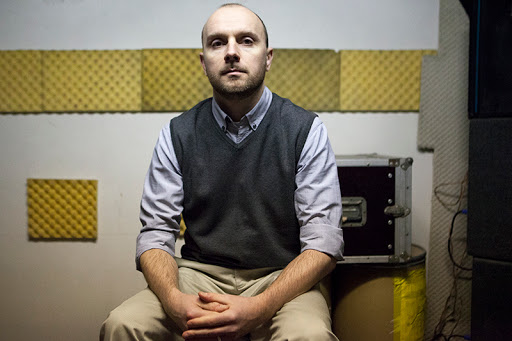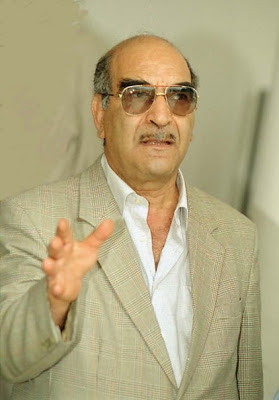„Black Manhattan“ James Weldon Johnson (Da Capo Press, 1991)
In this classic work, first published in 1930, James Weldon Johnson, one of the leading lights of the Harlem Renaissance, combined the skills of the historian, social scientist, and the reporter to trace the New York black experience from the earliest settlements on Chatham Square during the pre-revolutionary period to the triumphant achievements of Harlem in the 1920s. But Black Manhattan is by no means simply history; It illuminates Johnson and his contributions to both black literature and black organizations; it provides us with an intimate account of the black theatrical and musical world of which Johnson had been a part; and it raises searching questions about the black people's struggle to find their identity. Black Manhattan remains one of the essential books on the black American experience, losing none of its resonance and value after many decades.
........................
Title: „Black Manhattan“
Author: James Weldon Johnson
Publisher: Da Capo Paperback
Year: 1930
Number of pages: 284
........................
Title: „Black Manhattan“
Author: James Weldon Johnson
Publisher: Da Capo Paperback
Year: 1930
Number of pages: 284
........................
Opening Page „Black Manhattan“
James Weldon Johnson
(Da Capo Press, 1991)
James Weldon Johnson "BLACK MANHATTANN"
New York: Alfred A Knopf, 1930
(First edition)
(First edition)
:: Table of Contents ::
Chapter I.
The black city within the white
Harlem, the metropolis of the Negro world
The anomaly of it
The beginning of the story of the Negro in New York
The Negro, five per cent of the population in 1626
Slavery under the Dutch
The beginning of the colony of black freemen
Growth of slavery under the English
The slave insurrection of 1712
The revolt of 1742
Number of slaves and freemen in New York at close of Revolutionary War
Chapter II.
Changes in sentiment wrought by spirit of the Revolution
Forming of the Manumission Society, John Jay, president; Alexander Hamilton, secretary
Steps towards abolition of slavery
Efforts made by Negroes in New York
Methods employed
Number of Negroes in New York at close of Civil War
Chapter III.
Beginnings of education
African Free School established in 1787; first free school in New York
Report on African Free School by committee from Common Council of the city
Growth of educated leadership
Organization of churches
African Methodist Episcopal Zion Church organized, 1796
Negro Dutch Reformed Church, 1826
Widening of gap between white and black Christianity
Closing of gap between white and black education
Negro pupils and teachers in New York public school system
Chapter IV.
Period between abolishment of slavery in the state (1827) and in the nation (1863)
Negro suffrage in New York
Precarious situation of the freemen
Founding of Freedom's Journal, first Negro newspaper, in 1827
Growth of Negro press and part played by it in New York
Black anti-slavery agitators: Frederick Douglass,
Samuel Ringgold Ward, Henry Highland Garnett, Alexander Crummell,
James W. C. Pennington, Sojourner Truth, Harriet Tubman
Slave insurrections in the South; their effect on the Negro freemen in the North
The Negro freemen, a problem and a menace
Chapter V.
Rise of the idea of Negro colonization
Paul Cuffee, the first colonizer
The failure of colonization schemes
Attitude of Douglass and other leaders towards colonization
New economic pressure on Negroes in New York
Effect of rising tide of immigration on Negroes in New York
Chapter VI.
Outbreak of the Civil War
Pro-slavery sentiment in New York City
The fight for the chance to fight
New York Negro regiments in the war
The Draft Riots in New York City
The close of the war, and the lull that followed
Shift of race interests and activities to the South
Frederick Douglass, great New Yorker
Chapter VII.
Where the Negro lived in the earliest days of New York City
The steady shift northward
Sectional pride of the Greenwich Village colony
The shift to the upper Twenties and lower Thirties, west of Sixth Avenue
Brooklyn becomes centre of social life and respectability
Change in racial activities of the Negro in New York
Era of activities in the professional sports
The jockeys, the baseball players, the prize-fighters
Molineaux, the first American champion
His fight with Cribb in England for the championship of the world
Bill Richmond, New York Negro, a factor in the English prize-ring
World champions
New York, social and business centre of the Negro professionals in sports
Growth of New York's black Bohemia
Chapter VIII.
New York's black Bohemia and its clubs
Where Negro theatrical and artistic effort was nourished
A cut-back to the earliest beginnings on the stage
The African Company in classic plays, 1821
Ira Aldridge, tragedian
His success in England and on the Continent
Ira Aldridge Memorial Chair for Shakespeare Memorial Theatre at Stratford-on-Avon
Actual professional start of Negro in American theatre made on minstrel stage
White Negro minstrels and black Negro minstrels
Sam Lucas
Charles Frohman started as a minstrel manager
The Frohmans, Sam Lucas, and his diamonds
Negro minstrelsy, the foundation of the middle period of Negro theatrical development
Chapter IX.
The middle theatrical period
The Creole Show
South Before the War
The Octoroons
Oriental America
Worth's Museum
Bob Cole, a versatile genius
Some concert singers
Sissieretta Jones, the ``Black Patti''
Black Patti's Troubadours
A Trip to Coontown
Clorindy, The Origin of the Cake-Walk
Ernest Hogan
Chapter X.
Williams and Walker come from out of the West
They make the cake-walk famous
They issue challenge for a cake-walk contest to William K. Vanderbilt
They play before King Edward
Bert Williams joins Ziegfeld Follies
Cole and Johnson
The Shoofly Regiment and The Red Moon
Chapter XI.
Negro as maker of nation's songs
"Listen to the Mocking Bird''
Chapter I.
The black city within the white
Harlem, the metropolis of the Negro world
The anomaly of it
The beginning of the story of the Negro in New York
The Negro, five per cent of the population in 1626
Slavery under the Dutch
The beginning of the colony of black freemen
Growth of slavery under the English
The slave insurrection of 1712
The revolt of 1742
Number of slaves and freemen in New York at close of Revolutionary War
Chapter II.
Changes in sentiment wrought by spirit of the Revolution
Forming of the Manumission Society, John Jay, president; Alexander Hamilton, secretary
Steps towards abolition of slavery
Efforts made by Negroes in New York
Methods employed
Number of Negroes in New York at close of Civil War
Chapter III.
Beginnings of education
African Free School established in 1787; first free school in New York
Report on African Free School by committee from Common Council of the city
Growth of educated leadership
Organization of churches
African Methodist Episcopal Zion Church organized, 1796
Negro Dutch Reformed Church, 1826
Widening of gap between white and black Christianity
Closing of gap between white and black education
Negro pupils and teachers in New York public school system
Chapter IV.
Period between abolishment of slavery in the state (1827) and in the nation (1863)
Negro suffrage in New York
Precarious situation of the freemen
Founding of Freedom's Journal, first Negro newspaper, in 1827
Growth of Negro press and part played by it in New York
Black anti-slavery agitators: Frederick Douglass,
Samuel Ringgold Ward, Henry Highland Garnett, Alexander Crummell,
James W. C. Pennington, Sojourner Truth, Harriet Tubman
Slave insurrections in the South; their effect on the Negro freemen in the North
The Negro freemen, a problem and a menace
Chapter V.
Rise of the idea of Negro colonization
Paul Cuffee, the first colonizer
The failure of colonization schemes
Attitude of Douglass and other leaders towards colonization
New economic pressure on Negroes in New York
Effect of rising tide of immigration on Negroes in New York
Chapter VI.
Outbreak of the Civil War
Pro-slavery sentiment in New York City
The fight for the chance to fight
New York Negro regiments in the war
The Draft Riots in New York City
The close of the war, and the lull that followed
Shift of race interests and activities to the South
Frederick Douglass, great New Yorker
Chapter VII.
Where the Negro lived in the earliest days of New York City
The steady shift northward
Sectional pride of the Greenwich Village colony
The shift to the upper Twenties and lower Thirties, west of Sixth Avenue
Brooklyn becomes centre of social life and respectability
Change in racial activities of the Negro in New York
Era of activities in the professional sports
The jockeys, the baseball players, the prize-fighters
Molineaux, the first American champion
His fight with Cribb in England for the championship of the world
Bill Richmond, New York Negro, a factor in the English prize-ring
World champions
New York, social and business centre of the Negro professionals in sports
Growth of New York's black Bohemia
Chapter VIII.
New York's black Bohemia and its clubs
Where Negro theatrical and artistic effort was nourished
A cut-back to the earliest beginnings on the stage
The African Company in classic plays, 1821
Ira Aldridge, tragedian
His success in England and on the Continent
Ira Aldridge Memorial Chair for Shakespeare Memorial Theatre at Stratford-on-Avon
Actual professional start of Negro in American theatre made on minstrel stage
White Negro minstrels and black Negro minstrels
Sam Lucas
Charles Frohman started as a minstrel manager
The Frohmans, Sam Lucas, and his diamonds
Negro minstrelsy, the foundation of the middle period of Negro theatrical development
Chapter IX.
The middle theatrical period
The Creole Show
South Before the War
The Octoroons
Oriental America
Worth's Museum
Bob Cole, a versatile genius
Some concert singers
Sissieretta Jones, the ``Black Patti''
Black Patti's Troubadours
A Trip to Coontown
Clorindy, The Origin of the Cake-Walk
Ernest Hogan
Chapter X.
Williams and Walker come from out of the West
They make the cake-walk famous
They issue challenge for a cake-walk contest to William K. Vanderbilt
They play before King Edward
Bert Williams joins Ziegfeld Follies
Cole and Johnson
The Shoofly Regiment and The Red Moon
Chapter XI.
Negro as maker of nation's songs
"Listen to the Mocking Bird''
"Carve dat 'Possum''
James Bland, "Carry Me Back to Old Virginny", "Oh, dem Golden Slippers", "In the Morning by the Brightlight", "In the Evening by the Moonlight"
Gussie L. Davis, Ernest Hogan, Cole and Johnson, and other makers of songs
Harry T. Burleigh, J. Rosamond Johnson, and Will Marion Cook
The West Fifty-third Street centre
The Marshall Hotel
Birth of the jazz orchestra
Jim Europe and the Clef Club
W. C. Handy and the blues
Chapter XII.
The race riot of 1900
New York Negroes organize for action
The Citizens Protective League, the Afro-American Council
The national situation of the Negro
Booker T. Washington
W. E. Burghardt Du Bois
The Niagara Movement
The National Association for the Advancement of Colored People
The National Urban League
Chapter XIII.
The trek northward
The conquest of Harlem
The invasion
The opposition
The outbreak of the World War
Black labour at a premium
The exodus north
Jobs and money plentiful
The purchase of Harlem
Taken over without violence
The migrants to New York, Southern and West Indian
They quickly become New Yorkers
New York's tolerant attitude
Will the Negroes hold Harlem?
Chapter XIV.
The fame of Harlem
Night life in the Negro metropolis
Other modes of enjoyment, strolling, going to church, parades
The churches and their place in Negro life
The "sets'' in Harlem, respectable, social, fast, and underworld
Chapter XV.
Growth of a Negro theatre in Harlem
The Lafayette and the Lincoln players
The Darktown Follies
Beginning of the third theatrical period
The Colored Players open at the Garden Theatre, April 5, 1917
The Harlem night-clubs, nurseries for talent
The Krigwa Players
Chapter XVI.
Charles Gilpin in Drinkwater's Abraham Lincoln
Charles Gilpin in O'Neill's Emperor Jones
The Drama League dinner, and the commotion it caused
Other playwrights who experimented with the Negro as dramatic material
Propaganda plays
Then came along Shuffle Along
Miller and Lyles, and Sissle and Blake
Some more "serious'' plays
Paul Robeson in O'Neill's All God's Chillun Got Wings
Riots in the air
Florence Mills, the child artist, the incomparable comedienne
Her death
Chapter XVII.
A Negro playwright and his play
More plays
Jules Bledsoe in Green's in Abraham's Bosom
Still more plays and musical comedies
The Theatre Guild produces Porgy
Blackbirds of 1928, with Bill Robinson and his dancing feet
Still more plays and comedies
Two other Negro playwrights attempt Broadway; one succeeds
The Green Pastures, the high mark of the Negro in the theatre
Seventy-five years of change in the position of the Negro in the theatre
Changes in the last twenty years, the last ten years
Wellknown names
Ground gained by Negro actor and lost by Negro playwright
Harlem's relation to the Negro in the ``Broadway'' theatre
The Negro in the phonograph, radio, and moving-picture fields
The blues and some blues-singers
Carl Van Vechten's estimate of them
Chapter XVIII.
Harlem at the beginning of 1917
Stirrings of a new-born community
Birth of radicalism
Entry of the United States into the World War and its effect on Harlem
The Fifteenth Regiment formed; in camp; at the front; back home; under the Victory Arch
The Silent Protest Parade
The East St. Louis riots
Negro New York takes up its traditional role as defender
The Houston Affair
Committee of New York Negroes go before President Wilson with a petition
Prejudice follows the American black troops to France
Rebirth of radicalism
The radical press and the men behind it
The rise of Marcus Garvey
His fall, and some reasons for it
Garvey a tragic figure
Chapter XIX.
The literary and artistic emergence of the Negro
A glance backward over the record of the Negro as a creative artist
The post-war poets
Claude McKay, a voice of power
The younger poets
Countee Cullen, Langston Hughes
The prosewriters
Jean Toomer, Walter White, Claude McKay, and others
The Harlem Number of the Survey Graphic
Some incentives to literary effort, the Crisis prizes and Opportunity prizes
Advance in music and other arts
Chapter XX.
Harlem still in the making
Harlem more than a community; a large-scale laboratory experiment in the race problem
Many facts discovered
Two hundred thousand Negroes live in the centre of Manhattan without race friction
Harlem Negroes an integral part of the citizenry of New York
Internal effects of the experiment
External effects
The influence of Harlem in shaping and reshaping public opinion about the Negro
One sentence with regard to the future
James Bland, "Carry Me Back to Old Virginny", "Oh, dem Golden Slippers", "In the Morning by the Brightlight", "In the Evening by the Moonlight"
Gussie L. Davis, Ernest Hogan, Cole and Johnson, and other makers of songs
Harry T. Burleigh, J. Rosamond Johnson, and Will Marion Cook
The West Fifty-third Street centre
The Marshall Hotel
Birth of the jazz orchestra
Jim Europe and the Clef Club
W. C. Handy and the blues
Chapter XII.
The race riot of 1900
New York Negroes organize for action
The Citizens Protective League, the Afro-American Council
The national situation of the Negro
Booker T. Washington
W. E. Burghardt Du Bois
The Niagara Movement
The National Association for the Advancement of Colored People
The National Urban League
Chapter XIII.
The trek northward
The conquest of Harlem
The invasion
The opposition
The outbreak of the World War
Black labour at a premium
The exodus north
Jobs and money plentiful
The purchase of Harlem
Taken over without violence
The migrants to New York, Southern and West Indian
They quickly become New Yorkers
New York's tolerant attitude
Will the Negroes hold Harlem?
Chapter XIV.
The fame of Harlem
Night life in the Negro metropolis
Other modes of enjoyment, strolling, going to church, parades
The churches and their place in Negro life
The "sets'' in Harlem, respectable, social, fast, and underworld
Chapter XV.
Growth of a Negro theatre in Harlem
The Lafayette and the Lincoln players
The Darktown Follies
Beginning of the third theatrical period
The Colored Players open at the Garden Theatre, April 5, 1917
The Harlem night-clubs, nurseries for talent
The Krigwa Players
Chapter XVI.
Charles Gilpin in Drinkwater's Abraham Lincoln
Charles Gilpin in O'Neill's Emperor Jones
The Drama League dinner, and the commotion it caused
Other playwrights who experimented with the Negro as dramatic material
Propaganda plays
Then came along Shuffle Along
Miller and Lyles, and Sissle and Blake
Some more "serious'' plays
Paul Robeson in O'Neill's All God's Chillun Got Wings
Riots in the air
Florence Mills, the child artist, the incomparable comedienne
Her death
Chapter XVII.
A Negro playwright and his play
More plays
Jules Bledsoe in Green's in Abraham's Bosom
Still more plays and musical comedies
The Theatre Guild produces Porgy
Blackbirds of 1928, with Bill Robinson and his dancing feet
Still more plays and comedies
Two other Negro playwrights attempt Broadway; one succeeds
The Green Pastures, the high mark of the Negro in the theatre
Seventy-five years of change in the position of the Negro in the theatre
Changes in the last twenty years, the last ten years
Wellknown names
Ground gained by Negro actor and lost by Negro playwright
Harlem's relation to the Negro in the ``Broadway'' theatre
The Negro in the phonograph, radio, and moving-picture fields
The blues and some blues-singers
Carl Van Vechten's estimate of them
Chapter XVIII.
Harlem at the beginning of 1917
Stirrings of a new-born community
Birth of radicalism
Entry of the United States into the World War and its effect on Harlem
The Fifteenth Regiment formed; in camp; at the front; back home; under the Victory Arch
The Silent Protest Parade
The East St. Louis riots
Negro New York takes up its traditional role as defender
The Houston Affair
Committee of New York Negroes go before President Wilson with a petition
Prejudice follows the American black troops to France
Rebirth of radicalism
The radical press and the men behind it
The rise of Marcus Garvey
His fall, and some reasons for it
Garvey a tragic figure
Chapter XIX.
The literary and artistic emergence of the Negro
A glance backward over the record of the Negro as a creative artist
The post-war poets
Claude McKay, a voice of power
The younger poets
Countee Cullen, Langston Hughes
The prosewriters
Jean Toomer, Walter White, Claude McKay, and others
The Harlem Number of the Survey Graphic
Some incentives to literary effort, the Crisis prizes and Opportunity prizes
Advance in music and other arts
Chapter XX.
Harlem still in the making
Harlem more than a community; a large-scale laboratory experiment in the race problem
Many facts discovered
Two hundred thousand Negroes live in the centre of Manhattan without race friction
Harlem Negroes an integral part of the citizenry of New York
Internal effects of the experiment
External effects
The influence of Harlem in shaping and reshaping public opinion about the Negro
One sentence with regard to the future








